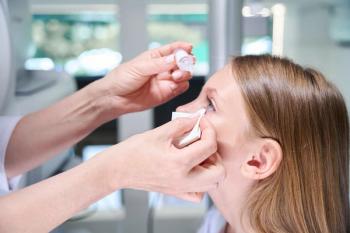
- June digital edition 2021
- Volume 13
- Issue 6
Ocular hygiene: The good and the bad during COVID-19
Some patients are more aware of ocular health, whereas others have worsening habits
During the COVID-19 pandemic, ODs have seen shifts, both good and bad, in ocular hygiene. Although some patients seem more aware of their ocular health, other patients’ ocular hygiene and contact lens habits have significantly worsened.
THE BAD
Worsened ocular hygiene
ODs may sometimes think they sound like broken records when reminding patients with dry eye to use artificial tears, or patients with blepharitis to maintain clean lid margins, and other contact lens patients to wear contact lenses as directed. Unfortunately, this past year spent at home in isolation may have been one of the worst for ocular hygiene.
Although no transmission of COVID-19 via contact lenses has been reported,1 some patients say they have avoided touching their eyes for fear of causing infection or COVID-19 transmission. Others say they extend contact lens supplies for various reasons, including loss of vision insurance, fear of running out of lenses, and having no backup glasses.
When one avoids touching the eyes and face, staphylococcal bacteria on the eyelids, lashes, and biofilm of the lid margins might not be regularly removed, resulting in an increased incidence of ocular inflammation. To worsen the scenario, contact lens patients with blepharitis and meibomian gland dysfunction (MGD) typically experience worsened lipid buildup and deposits on their contact lenses.2,3
Poor ocular and contact lens hygiene
When poor ocular hygiene is coupled with poor contact lens hygiene, the result can become a vicious cycle of local inflammations including bacterial hordeolums and noninfectious chalazions attributed to clogged meibomian glands.
To make matters worse, patients with or without contact lenses who were not already treating dry eye disease or blepharitis before the pandemic may also experience additional ocular insults related to mask-associated dry eye, coupled with a decreased blink rate from increased digital device usage.2
The tear film acts as an essential barrier against pathogenic invasion, and it may be compromised if an ill-fitting mask or excess computer use causes evaporation to occur more rapidly.2,3 Although universal, public mask use has been essential during the COVID-19 pandemic to reduce disease transmission through the mouth and nose, the eye remain unprotected and vulnerable to infection. Additionally, the eyes may be further compromised by irritation from an improperly fitted mask.2
Bacteria exhaled behind ill-fitted face masks may have caused worsened ocular hygiene and styes during the pandemic. The humid environment under masks, created by our own breath, generates a perfect breeding ground for organisms including bacteria, fungi, and Demodex mites to grow.2 Styes, blepharitis, and Demodex infestations can grow quickly out of control when left untreated.
Recommendations
Options are available to improve ocular hygiene. Avenova (NovaBay), a 0.01% hypochlorous acid spray, is available over the counter to kill viruses and bacteria that can lead to MGD and symptoms associated with blepharitis.3 Sprayed twice daily to clean eyelashes and eyelids, Avenova can help patients experiencing contact lens intolerance and other chronic eye conditions. NovaBay claims Avenova is effective against SARS-CoV-2 on hard surfaces.3
Eyelid wipes such as OCuSOFT Lid Scrubs can help remove debris, excess oils, and dead skin cells from the lid margin without negative effects on tear break-up time or ocular surface staining.4 I recommend OCuSOFT Lid Scrub Plus because its formulation does not require rinsing, increasing convenience. Cliradex Towelettes are a preservative-free option that includes a tea tree oil ingredient recommended when Demodex folliculorum is suspected.4
Nearly half of blepharitis cases in the United States are caused by Demodex mites. Tarsus Pharmaceuticals’ proposed drop formulation, if approved, would be the first to treat Demodex-associated blepharitis. Tarsus recently announced the start of its phase 3 trials for TP-03.5,6
THE GOOD
Improved ocular hygiene
Although some patients have presented with worsened ocular hygiene during the pandemic, time in quarantine has shifted the perspectives of others to the importance of good health. Consequently, some patients have reported more diligent use of artificial tears, lid scrubs, hot compress masks, and other at-home treatment options previously recommended by their eye care providers.
Interestingly, research shows that contact lens adherence and hand-washing before contact lens application and removal significantly improved during the pandemic.7 This is likely because of the growth in public awareness of hand-washing habits. Since the height of the pandemic, many patients have inquired about lens modalities and daily disposable options after considering the convenience, comfort, and quality compared with other lenses.
Words of advice
To further encourage good hygiene, I have been diligent in educating patients on the importance of maintaining optimal ocular health. If a symptomatic patient has worn extended wear lenses, the pandemic presented the perfect excuse to get to the root of the problem, whether lens fit, modality, materials, or even untreated ocular surface disease due to poor ocular hygiene.
Rather than dismissing a patient’s symptoms as normal, consider offering a trial of a daily disposable lens to compare with a current extended wear setup. Providing the opportunity for patients to try daily disposables has helped me with conversions to daily lenses throughout the pandemic.
To ensure best hygiene practices for patients in an extended wear lens, I recommend hydrogen peroxide disinfection such as ClearCare (Alcon).8 Educating patients on proper disinfection has revealed that very few people read the instructions.
Patients need and appreciate a reminder of ocular hygiene basics, including the importance of keeping lids and lashes clean, washing hands before lens application and removal, and how to disinfect contact lenses. ODs must continue to reiterate the importance of good ocular health, and they may need to offer new advice in the time of a pandemic.
References
1. Jones L, Walsh K, Willcox M, Morgan P, Nichols J. The COVID-19 pandemic: important considerations for contact lens practitioners. Cont Lens Anterior Eye. 2020;43(3):196-203. doi:10.1016/j.clae.2020.03.012
2. Moshirfar M, West WB Jr, Marx DP. Face mask-associated ocular irritation and dryness. Ophthalmol Ther. 2020;9(3):397-400. doi:10.1007/s40123-020-00282-6
3. Sindt CW. Wash away your old hygiene strategy. Review of Cornea & Contact Lenses. May 15, 2014. Accessed May 10, 2021. https://www. reviewofcontactlenses.com/article/wash-away-your-old-hygiene-strategy
4. Murphy O, O’Dwyer V, Lloyd-McKernan A. The effect of lid hygiene on the tear film and ocular surface, and the prevalence of Demodex blepharitis in university students. Cont Lens Anterior Eye. 2020;43(2):159-168. doi:10.1016/j.clae.2019.09.003
5. Paulsen AJ, Cruickshanks KJ, Fischer ME, et al. Dry eye in the beaver dam offspring study: prevalence, risk factors, and health-related quality of life. Am J Ophthalmol. 2014;157(4):799806. doi:10.1016/j.ajo.2013.12.023
6. Schaumberg DA, Nichols JJ, Papas EB, Tong L, Uchino M, Nichols KK. The international workshop on meibomian gland dysfunction: report of the subcommittee on the epidemiology of, and associated risk factors for, MGD. Invest Ophthalmol Vis Sci. 2011;52(4):1994-2005. doi:10.1167/iovs.10-6997e
7. Vianya-Estopa M, Wolffsohn JS, Beukes E, Trott M, Smith L, Allen PM. Soft contact lens wearers’ compliance during the COVID-19 pandemic. Cont Lens Anterior Eye. Published online August 14, 2020. doi:10.1016/j.clae.2020.08.003
8. Contact lens care systems & solutions. Centers for Disease Control and Prevention. Updated September 11, 2020. Accessed May 10, 2021. https://www. cdc.gov/contactlenses/care-systems.html#hydrogen-peroxide
Articles in this issue
over 4 years ago
Know the basics of a pediatric eye examover 4 years ago
How antibiotic resistance happensover 4 years ago
Top 10 digital resources for ODsover 4 years ago
Mask Associated Dry Eyeover 4 years ago
How to address face mask–associated dry eyeover 4 years ago
IOP-lowering medication reviewover 4 years ago
When times aren’t “20/happy”Newsletter
Want more insights like this? Subscribe to Optometry Times and get clinical pearls and practice tips delivered straight to your inbox.













































.png)


